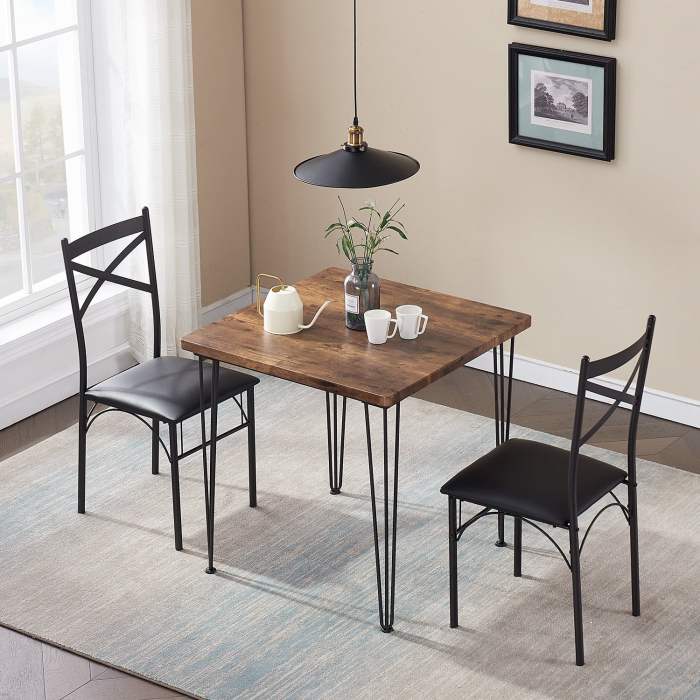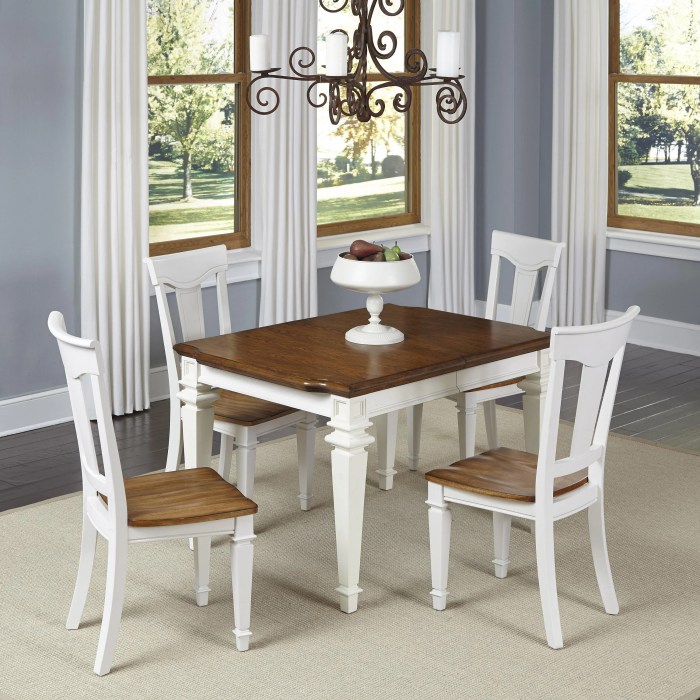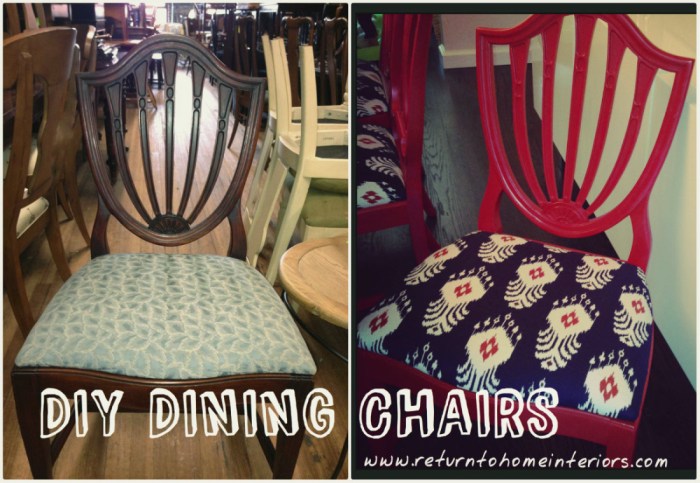DIY dining room chairs offer a unique opportunity to personalize your space and create furniture that reflects your individual style. Whether you’re looking to restore vintage finds, build from scratch, or upcycle old materials, the possibilities are endless. This guide explores various styles, materials, techniques, and projects to inspire your own DIY dining room chair journey.
From classic to modern, farmhouse to industrial, there’s a DIY dining room chair style to suit every taste. Discover the best materials for durability and aesthetics, learn essential tools and techniques, and delve into step-by-step guides for restoration and building. Explore creative upcycling ideas and discover how to create comfortable seat cushions. We’ll cover finishes and treatments, safety precautions, and showcase inspiring DIY projects to fuel your creativity.
Choosing the Right Materials

The materials you choose for your DIY dining room chairs will significantly impact their durability, cost, and aesthetic appeal. This section will explore common materials and their advantages and disadvantages to help you make an informed decision.
Materials for Dining Room Chairs
Here’s a list of common DIY materials for dining room chairs:
- Wood
- Metal
- Fabric
- Upholstery
The choice of material depends on your preferences, budget, and the desired style of your dining room chairs.
Comparing Material Properties
This table compares the pros and cons of each material:
| Material Type | Pros | Cons |
|---|---|---|
| Wood |
|
|
| Metal |
|
|
| Fabric |
|
|
| Upholstery |
|
|
Remember, the best material for your DIY dining room chairs depends on your individual needs and preferences. Consider the pros and cons of each material before making your final decision.
DIY Chair Building Techniques: Diy Dining Room Chairs

Building a chair from scratch is a rewarding project that requires careful planning and execution. It’s an excellent way to personalize your dining room, create a unique piece of furniture, and save money. This section will explore various techniques and methods to guide you through the process.
Woodworking Joints
Woodworking joints are crucial for assembling the chair’s frame, ensuring its strength and stability. The choice of joint depends on the chair’s design, desired strength, and the tools you have available.
- Mortise and Tenon Joint: This classic joint is strong and durable, ideal for creating a sturdy chair frame. It involves creating a rectangular hole (mortise) in one piece of wood and a corresponding tenon (projection) on the other piece. The tenon fits snugly into the mortise, creating a strong connection.
- Dovetail Joint: Known for its exceptional strength and visual appeal, the dovetail joint is commonly used in furniture making. It involves interlocking wedge-shaped pieces of wood that create a tight and secure connection. This joint is more challenging to cut than a mortise and tenon but offers superior strength and resistance to separation.
- Pocket Hole Joint: A more modern joint that uses a special jig to create angled holes for screws. It’s a relatively easy and fast method, suitable for less visible areas of the chair. While it’s not as strong as mortise and tenon or dovetail, it’s still a viable option for sturdy construction.
Upholstery Methods
Upholstery techniques involve adding padding and fabric to the chair’s seat and back for comfort and aesthetics.
- Staple Gun Upholstery: This common method uses a staple gun to attach fabric to the chair’s frame. It’s a relatively simple technique, but it requires practice to achieve a neat and professional finish.
- Sewn Upholstery: This method involves sewing fabric to the chair’s frame, offering a more durable and polished look. It requires sewing skills and knowledge of upholstery techniques, making it a more challenging but rewarding approach.
- Foam Padding: Adding foam padding to the chair’s seat and back is essential for comfort. Different densities and thicknesses of foam are available to suit various seating preferences.
Chair Leg Construction
Chair legs are the foundation of the chair, supporting its weight and providing stability. Several techniques can be used to create chair legs, each with its own advantages and disadvantages.
| Technique | Description | Application |
|---|---|---|
| Tapered Legs: | These legs are narrower at the top and wider at the bottom, creating a visually appealing and stable design. | Commonly used for traditional and classic chairs. |
| Straight Legs: | Straight legs offer a simple and modern look, often found in contemporary chair designs. | Suitable for minimalist or modern styles. |
| Turned Legs: | Turned legs involve using a lathe to create decorative and intricate shapes. | Add a touch of elegance and sophistication to chairs. |
| Spindle Legs: | These legs are thin and often have a rounded or tapered shape, offering a delicate and airy look. | Ideal for chairs with a more lightweight and elegant aesthetic. |
Chair Finishes and Treatments

The final stage of your DIY chair project is choosing the right finish. This step will not only enhance the chair’s aesthetic appeal but also protect it from wear and tear. There are several finishes and treatments available, each offering unique characteristics in terms of appearance and durability.
Chair Finishes and Treatments
Choosing the right finish for your DIY chairs depends on the desired look, durability, and the type of wood used. Here’s a breakdown of common finishes:
| Finish Type | Application | Effects |
|---|---|---|
| Paint | Applied with a brush, roller, or spray gun in multiple coats. | Provides a durable, opaque finish that hides the wood grain. Offers a wide range of colors and finishes, from matte to gloss. |
| Stain | Applied with a brush or cloth, allowing the wood grain to show through. | Enhances the natural color and grain of the wood. Available in various colors and finishes, including oil-based, water-based, and gel stains. |
| Varnish | Applied with a brush or spray gun in multiple thin coats. | Creates a protective, transparent finish that enhances the wood’s natural beauty and provides a durable layer against scratches and spills. Available in gloss, semi-gloss, satin, and matte finishes. |
Safety Precautions for DIY Projects
Building your own dining room chairs can be a rewarding experience, but it’s crucial to prioritize safety throughout the process. Working with power tools and wood requires vigilance and proper precautions to prevent injuries.
Importance of Safety Gear, Diy dining room chairs
Wearing appropriate safety gear is essential for protecting yourself from potential hazards. This includes:
- Gloves: Protect your hands from splinters, cuts, and rough surfaces.
- Goggles: Shield your eyes from flying debris, sawdust, and wood chips.
- Dust Mask: Prevent inhaling wood dust, which can irritate your respiratory system.
- Hearing Protection: Reduce noise levels from power tools to protect your hearing.
These safety measures can significantly reduce the risk of injury and ensure a safe working environment.
Safety Tips for Handling Power Tools
Power tools can be dangerous if not used correctly. Here are some essential safety tips:
- Always unplug tools before making adjustments or cleaning them.
- Use the right tool for the job. Avoid using tools for tasks they are not designed for.
- Keep work areas clean and free of clutter. This reduces the risk of tripping or accidents.
- Secure workpieces properly. Use clamps or vices to prevent movement while cutting or sanding.
- Maintain tools regularly. Keep blades sharp and tools in good working order to prevent malfunctions.
- Never operate tools while under the influence of alcohol or drugs. This can impair judgment and increase the risk of accidents.
Safety Tips for Working with Wood
Woodworking involves sharp tools and potentially hazardous materials. Follow these tips to stay safe:
- Handle sharp tools with care. Use a cutting mat or workbench to protect your work surface and prevent accidental cuts.
- Use clamps or vices to secure wood pieces. This prevents movement while cutting or sanding, reducing the risk of injuries.
- Wear appropriate clothing. Avoid loose clothing or jewelry that could get caught in machinery.
- Be aware of wood dust. Use a dust mask to protect your respiratory system from inhaling wood dust, which can cause irritation and respiratory problems.
- Store wood properly. Keep wood dry and away from moisture to prevent warping and decay.
Embark on your DIY dining room chair adventure with confidence. With the right knowledge, tools, and a dash of creativity, you can transform your dining area into a space that reflects your personality and style. Whether you’re a seasoned DIY enthusiast or a beginner, this guide provides everything you need to create beautiful and functional dining room chairs that you’ll cherish for years to come.
Revamping your dining room chairs can be a fun and rewarding project. After all that hard work, you might need a boost of energy. Try making your own DIY electrolyte drinks to replenish your electrolytes and keep you going. Once you’re re-energized, you can get back to refinishing those chairs and adding your personal touch to your dining space.
